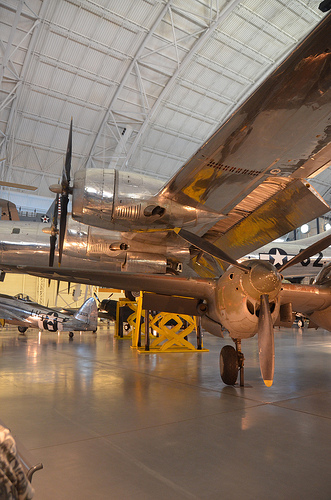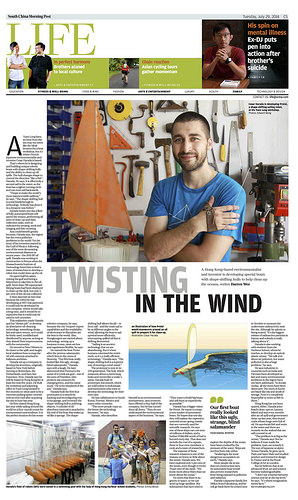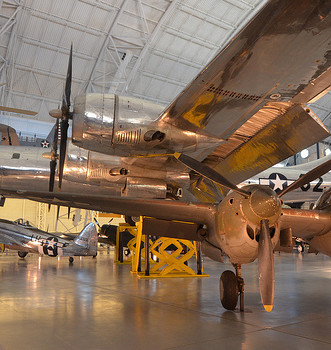Check out these china prototype business images:
Steven F. Udvar-Hazy Center: B-29 Superfortress “Enola Gay” panorama

Image by Chris Devers
Quoting Smithsonian National Air and Space Museum | Lockheed P-38J-ten-LO Lightning:
In the P-38 Lockheed engineer Clarence "Kelly" Johnson and his team of designers produced a single of the most effective twin-engine fighters ever flown by any nation. From 1942 to 1945, U. S. Army Air Forces pilots flew P-38s more than Europe, the Mediterranean, and the Pacific, and from the frozen Aleutian Islands to the sun-baked deserts of North Africa. Lightning pilots in the Pacific theater downed much more Japanese aircraft than pilots flying any other Allied warplane.
Maj. Richard I. Bong, America’s major fighter ace, flew this P-38J-10-LO on April 16, 1945, at Wright Field, Ohio, to evaluate an experimental technique of interconnecting the movement of the throttle and propeller handle levers. Nevertheless, his correct engine exploded in flight before he could conduct the experiment.
Transferred from the United States Air Force.
Manufacturer:
Lockheed Aircraft Firm
Date:
1943
Country of Origin:
United States of America
Dimensions:
General: 390 x 1170cm, 6345kg, 1580cm (12ft 9 9/16in. x 38ft four five/8in., 13988.2lb., 51ft 10 1/16in.)
Components:
All-metal
Physical Description:
Twin-tail boom and twin-engine fighter tricycle landing gear.
• • • • •
Quoting Smithsonian National Air and Space Museum | Boeing B-29 Superfortress "Enola Gay":
Boeing’s B-29 Superfortress was the most sophisticated propeller-driven bomber of Planet War II and the initial bomber to residence its crew in pressurized compartments. Even though designed to fight in the European theater, the B-29 discovered its niche on the other side of the globe. In the Pacific, B-29s delivered a selection of aerial weapons: traditional bombs, incendiary bombs, mines, and two nuclear weapons.
On August six, 1945, this Martin-built B-29-45-MO dropped the 1st atomic weapon used in combat on Hiroshima, Japan. 3 days later, Bockscar (on display at the U.S. Air Force Museum near Dayton, Ohio) dropped a second atomic bomb on Nagasaki, Japan. Enola Gay flew as the advance climate reconnaissance aircraft that day. A third B-29, The Excellent Artiste, flew as an observation aircraft on both missions.
Transferred from the United States Air Force.
Manufacturer:
Boeing Aircraft Co.
Martin Co., Omaha, Nebr.
Date:
1945
Country of Origin:
United States of America
Dimensions:
Overall: 900 x 3020cm, 32580kg, 4300cm (29ft 6 five/16in. x 99ft 1in., 71825.9lb., 141ft 15/16in.)
Materials:
Polished general aluminum finish
Physical Description:
4-engine heavy bomber with semi-monoqoque fuselage and higher-aspect ratio wings. Polished aluminum finish overall, regular late-Planet War II Army Air Forces insignia on wings and aft fuselage and serial quantity on vertical fin 509th Composite Group markings painted in black "Enola Gay" in black, block letters on decrease left nose.
Cesar HARADA & Protei on SCMP

Image by cesarharada.com
protei.org
scoutbots.com
Yuen Long farm an hour from the sea might not appear like the ideal place for a boat workshop, but it is where French- Japanese environmentalist and inventor Cesar Harada is based.
That is exactly where he is designing and developing exclusive robotic boats with shape-shifting hulls and the ability to clean up oil spills. The hull alterations shape to control the path “like a fish”, Harada, 30, says. It is efficiently a second sail in the water, so the boat has a tighter turning circle and can even sail backwards.
“I hope to make the world’s most manoeuvrable sailboat,” he says. “The shape-shifting hull is a real breakthrough in technology. No one has accomplished it in a dynamic way just before.”
Harada hopes 1 day a fleet of totally automated boats will patrol the oceans, performing all sorts of clean-up and information- collection tasks, such as radioactivity sensing, coral reef imaging and fish counting.
Asia could advantage drastically because, Harada says, the area has the worst pollution problems in the world. However the story of his invention began in the Gulf of Mexico, following one particular of the most devastating environmental disasters in current years – the 2010 BP oil spill. Harada was operating in building in Kenya when the Massachusetts Institute of Technology hired him to lead a group of researchers to create a robot that could clean up the oil.
He spent half his salary visiting the gulf and hiring a fisherman to take him to the oil spill. More than 700 repurposed fishing boats had been deployed to clean up the slick, but only three per cent of the oil was collected.
It then dawned on him that due to the fact the robot he was creating at MIT was patented, it could only be created by 1 business, which would take a long time, and it would be so pricey that it could only be utilized in rich countries.
This realisation created Harada quit his “dream job” to develop an alternative oil-cleaning technologies: something low cost, quickly and open-supply, so it could be freely used, modified and distributed by anyone, as long as they shared their improvements with the community.
He moved to New Orleans to be closer to the spill, and taught regional residents how to map the oil with cameras attached to balloons and kites.
Harada set up a firm to develop his invention, initially primarily based in New York prior to moving to Rotterdam, the Netherlands, and then San Francisco. Now, Harada says he will be based in Hong Kong for at least the next 5 years. He constructed his workshop and adjoining office in Yuen Long himself in 5 months on what utilized to be a concrete parking space covered with an iron roof after acquiring the site in June last year.
He 1st visited Hong Kong final year whilst sailing about the world on a four-month cruise for entrepreneurs and students. It is the perfect place for his ocean
robotics organization, he says, because the city’s import-export capabilities and the availability of electronics in Shenzhen are the ideal in the planet. Also, Hongkongers are excited about technology, setting up a company is straightforward, taxes are low and regulations versatile, he says.
He named the boat Protei after the proteus salamander, which lives in the caves of Slovenia. “Our very first boat really looked like this ugly, strange, blind salamander,” Harada
says with a laugh. He later discovered that Proteus is the nameofaGreekseagod–oneof the sons of Poseidon, who protects sea creatures by changing form, and the name stuck. “He is the shepherd of the sea,” Harada says.
Harada built the very first 4 prototypes in a month by hacking and reconfiguring toys in his garage, and invented the shape-shifting hull to pull lengthy objects. A cylinder of oil- absorbent material is attached to the finish of the boat that soaks up oil like a sponge. The shape-
shifting hull permits the jib – or front sail – and the major sail to be at various angles to the wind, permitting the boat to sail upwind much more efficiently, intercepting spilled oil that is drifting downwind.
“Sailing is an ancient technology that we are abandoning. But it’s how humans colonised the whole earth, so it is a truly effective technology,” Harada says. “The shape-shifting hull is a superior way of steering a wind vessel.”
The prototype is now in its 11th generation. The hull, which measures about a metre extended, looks and moves like a snake’s spine. Harada built 10 prototypes this month, which are sold online to men and women and institutions who want to create the technology for their personal uses.
He has collaborators in South Korea, Norway, Mexico and many other countries.
“The a lot more folks copy us, the better the technologies becomes,” he says.
Harada, who describes himself as an environmental entrepreneur, says investors have supplied to purchase half of the business, but he has turned them all down. “They do not understand the environmental aspect of the organization,” he says.
“They want to construct huge boats and sell them as expensively as attainable.”
Harada has a larger vision for Protei. He wants to produce
a new marketplace of automated boats. He hopes that 1 day they will replace the costly, manned ocean-going vessels that are at present utilized for scientific investigation. He says
1 of these ships can expense tens of millions of dollars, and a further US,000 worth of fuel is burned every single day. That does not contain the price of a captain, three or four crew members, a cook and a team of researchers.
The expense of these investigation missions is a single of the motives we know so tiny about the ocean, Harada says. We have explored only 5 per cent of the ocean, even though it covers 70 per cent of the earth. “We know far more about Mars than we know about the ocean.”
He notes that there is no gravity in space, so we can send up large satellites. But submarines that have attempted to discover the depths of the ocean have been crushed by the stress of the water. Ships are not cost-free from threat, either.
“Seafaring is the most hazardous occupation on earth,” Harada says.
Much more people die at sea
than on construction sites.
An automated boat would
also stop researchers
from being exposed to pollution and radiation.
Harada’s Japanese household live 100km from Fukushima, and he will go back there for a third time
in October to measure the underwater radioactivity near the web site. Despite the fact that he admits to getting scared, “it’s the greatest release of radioactive particles in history and nobody is truly talking about it”.
Harada is also working with students from the Harbour College, where he teaches, to develop an optical plastic sensor. “We talk a lot about air pollution, but water pollution is also a large difficulty,” he says.
He says industries in countries such as India and Vietnam have created so quick and numerous environmental troubles in the area have not been addressed. “In Kerala [India], all the rivers have been destroyed. The rivers in Kochi are black like ink and smell of sewage. Now it is entirely not possible to swim or fish in them.”
Hong Kong has not been spared, either. Harada joins beach clean-ups on Lamma Island and says even months soon after an oil spill and government clean-up last year, they found crabs whose lungs have been full of oil. He says locals fish and swim in the water and there are mussels on the seabed that are nonetheless covered in oil.
“The dilemma is as large as the ocean,” Harada says. But he believes if man created the problem, man can remedy it. The son of Japanese sculptor Tetsuo Harada, he grew up in Paris and Saint Malo and studied product and interactive style in France and at the Royal College of Art in London.
But he believes that at an sophisticated level, art and science grow to be indistinguishable.
“I don’t see a barrier among science and art at the prime level,” he says. “It’s where imagination meets details.” darren.wee@scmp.com
